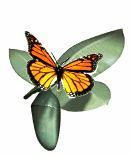A butterfly is an insect of the order Lepidoptera. Like all Lepidoptera, butterflies are notable for their unusual life cycle with a larval caterpillar stage, an inactive pupal stage, and a spectacular metamorphosis into a familiar and colourful winged adult form. Most species are day-flying so they regularly attract attention. The diverse patterns formed by their brightly coloured wings and their erratic yet graceful flight have made butterfly watching a fairly popular hobby.
Butterflies comprise the true butterflies (superfamily Papilionoidea), the skippers (Superfamily Hesperioidea) and the moth-butterflies (Superfamily Hedyloidea). Butterflies exhibit polymorphism, mimicry and aposematism. Some are known to migrate over large distances. Some butterflies have evolved symbiotic and parasitic relationships with social insects such as ants. Butterflies are important economically as one of the major agents of pollination. In addition, a number of species are pests, because they can damage domestic crops and trees.
Culturally, butterflies are a popular motif in the visual and literary arts.
Origin and distribution
Butterflies are nested within the evolutionary tree of moths. Their origins may date back to the Cretaceous Period, ending 65 million years ago.[1] Unfortunately, the fossil record is very limited. The oldest known fossil is an unnamed possible skipper butterfly from the Upper Palaeocene (around 57 million year old) of
Butterflies are today distributed throughout the world except in the very cold and arid regions. There are an estimated 17,500 species of butterflies (Papilionoidea) out of about 180,000 species of Lepidoptera.
Butterfly families
The five families of true butterflies usually recognized in the Papilionoidea are:-
- Family Papilionidae, the Swallowtails, Apollos and Birdwings
- Family Pieridae, the Whites and Yellows
- Family Lycaenidae, the Blues and Coppers, also called the Gossamer-Winged Butterflies
- Family Riodinidae, the Metalmark butterflies
- Family Nymphalidae, the Brush-footed butterflies
The superfamily Hesperioidea comprises one family only, albeit a large one, the skippers of family Hesperiidae, whereas the superfamily Hedyloidea also consists of a single family Hedylidae with about 40 species.
The four stages in the lifecycle of a butterfly
Unlike many insects, butterflies do not experience a nymph period, but instead go through a pupal stage which lies between the larva and the adult stage (the imago). Butterflies are termed as holometabolous insects, and go through complete metamorphosis.
It is a popular belief that butterflies have very short life spans. However, butterflies in their adult stage can live from a week to nearly a year depending on the species. Many species have long larval life stages while others can remain dormant in their pupal or egg stages and thereby survive winters.
Butterflies may have one or more broods per year. The number of generations per year varies from temperate to tropical regions with tropical regions showing a trend towards multivoltinism.
Habits
Butterflies feed primarily on nectar from flowers. Some also derive nourishment from pollen, tree sap, rotting fruit, dung, and dissolved minerals in wet sand or dirt. Butterflies play an important ecological role as pollinators.
As adults, butterflies consume only liquids and these are sucked by means of their proboscis. They feed on nectar from flowers and also sip water from damp patches. This they do for water, for energy from sugars in nectar and for sodium and other minerals which are vital for their reproduction. Several species of butterflies need more sodium than provided by nectar. They are attracted to sodium in salt and they sometimes land on people, attracted by human sweat. Besides damp patches, some butterflies also visit dung, rotting fruit or carcasses to obtain minerals and nutrients. In many species, this Mud-puddling behaviour is restricted to the males and studies have suggested that the nutrients collected are provided as a nuptial gift along with the spermatophore during mating.
Butterflies sense the air for scents, wind and nectar using their antennae. The antennae come in various shapes and colours. The hesperids have a pointed angle or hook to the antennae, while most other families show knobbed antennae. The antennae are richly covered with sensillae. A butterfly's sense of taste is coordinated by chemoreceptors on the tarsi, which work only on contact, and are used to determine whether an egg-laying insect's offspring will be able to feed on a leaf before eggs are laid on it. Many butterflies use chemical signals, pheromones, and specialized scent scales (androconia) and other structures (coremata or 'Hair pencils' in the Danaidae) are developed in some species.
Antennae shape in the lepidoptera from C. T. Bingham (1905)
Vision is well developed in butterflies and most species are sensitive to the ultraviolet spectrum. Many species show sexual dimorphism in the patterns of UV reflective patches. Color vision may be widespread but has been demonstrated in only a few species.
Some butterflies have organs of hearing and some species are also known to make stridulatory and clicking sounds.
Many butterflies, such as the Monarch butterfly, are migratory and capable of long distance flights. They migrate during the day and use the sun to orient themselves. They also perceive polarized light and use it for orientation when the sun is hidden.
Many species of butterfly maintain territories and actively chase other species or individuals that may stray into them. Some species will bask or perch on chosen perches. The flight styles of butterflies are often characteristic and some species have courtship flight displays. Basking is an activity which is more common in the cooler hours of the morning. Many species will orient themselves to gather heat from the sun. Some species have evolved dark wingbases to help in gathering more heat and this is especially evident in alpine forms.


0 komentar:
Posting Komentar